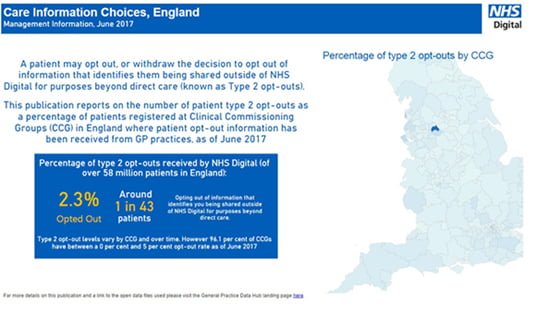NHS Digital’s GP Data Hub, which provides the public with a range of statistical information on GP practices, has gone live with its second phase.
It has now expanded to include information on the online services offered to patients, such as repeat prescription ordering and appointment booking access, practice level data on dementia, cervical screening and the numbers of patients who have opted out of data sharing.
Digital Health News used the latest tool to find out there is a total of 12.92% people at NHS Oldham CCG who have opted of out of sharing their data beyond direct care (type 2 opt-outs) compared to 0.98% in NHS Gloucestershire CCG.
“The update has also seen the addition of Sustainability and Transformation Plan maps to reports such as dementia and GP list size, to show the data at STP area level”, an NHS Digital spokeswoman said.
The GP Data Hub provides an online repository of statistics about individual GP practices in England and offers journalists, patients, charities and health care professionals with a single port of call on information.
This can range from the number of staff and patients at a practice to measurements on how well the practice is coping with public health concerns.
“Patients can use the data to compare their practice to neighbouring or former practices, and researchers and health care professionals are able to analyse data quickly and effectively”, the spokeswoman said.
The data hub, which launched in April this year, will see more roll-outs over the six months with more figures from a variety of health areas.
In its first stage statistics were added showing the number of patients registered at each practice and the number of people working at each practice.
It also charted Qualities Outcomes Framework (QOF) data, which contains information on the percentage of people suffering from different health conditions at practice, regional and care commissioning group (CCG) level.
Dave Roberts, head of business and operational delivery for NHS Digital, said the data hub is a great visual tool for professionals and patients who are interested in finding out statistical information about their local GP practices.
He said they hope it will encourage more people to engage with what is going on in the primary care sector.


1 August 2017 @ 12:32
I do wish they’d remember to include “GP” between “NHS” and “Digital Data Hub”!
26 July 2017 @ 15:23
Hi Gill, I work on this at NHS Digital. It’s not ‘easy’ to do this in PowerBI at the moment but we have received similar feedback from other users so we will look into this as part of our next release which will be due in September. At the moment you can compare practices within the same CCG on some of our reports (such as the patient online management information report) but I will feed this back to the team.
26 July 2017 @ 11:12
Will it be possible in the future to select more than one practice simultaneously so they can be viewed side by side?
25 July 2017 @ 10:26
NHExit is NHExit
25 July 2017 @ 07:00
So they’ve recorded where the opt outs live?
Which bit of opted out was difficult….. (yes I know you can’t id people from this but opt out is …. an opt out).